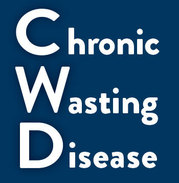 What is it? Chronic Wasting Disease (CWD) is a neurodegenerative
disease affecting deer, elk and moose (members of the cervidae family) and is
always fatal. Abnormally shaped infectious proteins called prions cause the disease
and convert normal proteins into infectious ones, which eventually leads to the
animal’s death. CWD was discovered in Colorado in the 1960’s and is found in
the United States, Canada, and more recently, in Europe. It belongs to a group
of diseases known as transmissible spongiform encephalopathies.
How is it
transmitted? The disease is believed to be spread from one animal to
another through direct contact and/or environmental contamination. Infectious
prions can be spread via saliva, feces, blood, urine, and other bodily fluids. CWD
and other prion diseases are difficult to control because, unlike bacteria and
viruses, prions are resistant to inactivation by heat, freezing, ultraviolet light,
and chemical disinfectants. Prions are also resilient in many environments and
can remain infectious for extended periods of time.
What are the signs
in deer, elk and moose? Because CWD is a slow and progressive disease, signs of
infection may take a long time to appear. Typical signs include behavioral
changes, lack of coordination, stumbling, tremors, drooling, and weight loss.
These are not the only symptoms and are not necessarily specific to CWD.
Animals exhibiting these clinical signs often die within months.
How is Chronic
Wasting Disease diagnosed? It is confirmed by testing tissue samples from a dead
animal’s central nervous system and/or lymph nodes. Tests, like
immunohistochemistry, work by detecting antigens (prions) in those tissues.
What is the
treatment? There is no treatment or vaccine for Chronic Wasting
Disease. The disease is fatal for infected deer, elk or moose.
Is there a risk to
people? Although CWD is not known to affect humans, caution is
advised. The Centers for Disease Control says to avoid eating meat from deer
and elk that look sick or test positive for CWD.
How can it be
prevented? Preventing CWD starts with surveillance, monitoring and early detection. Farmed
deer and elk, 12 months of age and older, must be tested for CWD if they die or
are slaughtered. In Minnesota, tissue samples (brain stem) are tested at the
University of Minnesota’s Veterinary Diagnostic Laboratory in St. Paul. Deer
and elk farms are also annually inspected by the Board and producers are
required to report all deer or elk deaths and when animals are moved into or out
of the herd. In the event of a positive test result for CWD, the Board will
quarantine the affected herd.
|